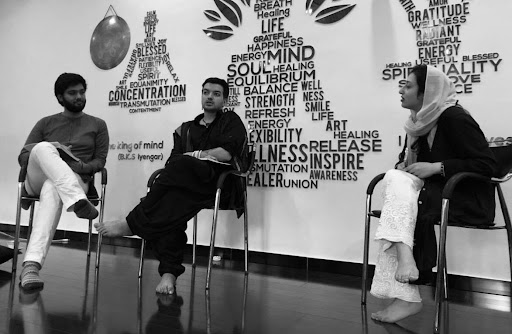
By: Zoha Fareed Chishti
At 4:00 pm, on October 16, around thirty people, including myself, sat scattered on the cushions placed on the floor of one of the rooms of Cloud 9 Wellness Centre, in Gulberg Lahore. At the front of the room, three people were seated; Arhum Sarfraz ‘23, co-president of Hum Ahang, Mahnoor Ghani ‘22, LUMS alumnus and moderator for the day, and Dr. Mohammad Moiz, Khwaja Sira Activist, Drag Artist, and an expert on Public Health and Policy. The discussion session slated under the second season of Hum Ahang’s Art as Existence series had just begun.
Hum Ahang’s Art as Existence series began last year, when Ghani, then Director for Seed of Change, wanted to look at how art engaged with lived realities of people, especially during the pandemic. The series has hosted photographers, painters, musicians and artists like Moiz, who expand on the horizons of traditional art.
Ghani opened the floor with a question on Art– this was immediately taken up by Moiz who deconstructed the Art and the Non-Art, with the help of audience engagement. Moiz, in agreement with the audience, concluded that Art, in essence, is reality, it is an act of being, it is existence– it is what is outside of the technical. They further discussed how Art is a shared manifestation; “it is outside of yourself, and it is not just for yourself.”
Moiz also touched upon the dichotomy of science and art, and it originates from the colonial legacy of biopolitics. “Art is scientific, science is art– this dichotomy comes as a by-product of colonial education which inherently focuses on population management,” Moiz argued. They further elaborated on this by drawing from the indigenous legacy of the subcontinent; our art is mixed with science, with spirituality and with philosophy. The dichotomy exists only to serve the labour market, they argued, it is designed to meet western notions of productivity and individual contribution.
The discussion was steered towards the relationship Art has with the modern economy. “You don’t have time to experience the Sama’a of the Qawwali so you go to sleep after a twelve minute Coke Studio version. You can’t stay up till 4 am to write poetry because you have to go to work in the morning,” Moiz explained. They argued that the modern economy has commercialized art; it is accessible but is it profound? Art is born, Moiz told their audience, as they reflected back to their creations, Shumaila Bhatti, and Phuddina Chutney. It can not always be strategised, as the commercial market requires.
Moiz also mentioned how they believe art is spiritual– yes, it can be consumer oriented, and today’s artists might create for it to be consumed, but that should not take away from the legacy we have inherited. They drew examples from Tawaifs and their relationship with their art; their raks and how “it is Divine, it is transcendent.” Ghani further questioned Moiz about the trajectory of sanitization of Art, which might take away from this Divinity. To this, Moiz argued that Art is also resistance, which is Divine in itself. “Fatway tau Manto par bhi lagay thay,” they mentioned, explaining that regulating art is not a contemporary invention of the state.
Sarfraz told The Post that they are proud of how Art as Existence challenges the modern notion of categorising people in functions and systems. “The kind of conversation we had with Moiz captures this essence; getting in touch with yourself,” he concluded.